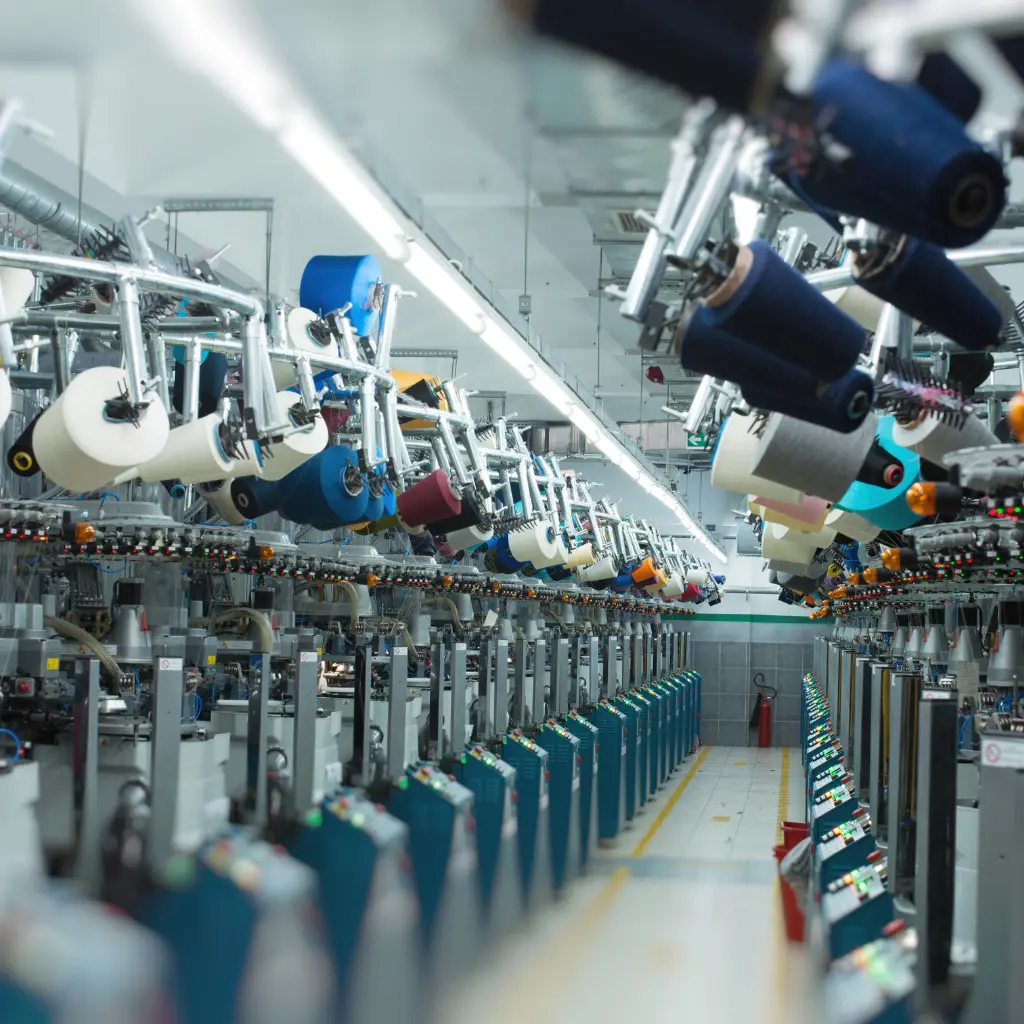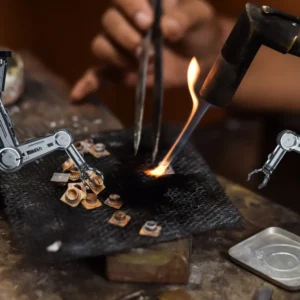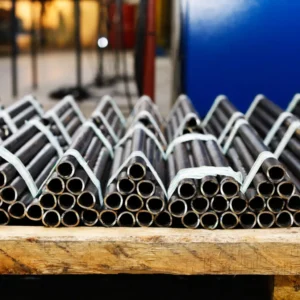
Threads and Tech
Weaving AI into Textile Manufacturing
Welcome to the realm where innovation threads through every fabric of the textile industry.
Are you interested in the latest advancements in textile manufacturing? If so, you’ll want to check out our article, “Weaving AI into Textile Manufacturing.” Discover how artificial intelligence revolutionizes textiles’ creation, inspection for quality, and design.
Get ready to be amazed by AI’s incredible impact on this industry! From efficient machinery and predictive insights to eco-friendly practices and fashion trend predictions, we’ll unravel AI’s profound effect on every aspect of this industry.
Along the way, we’ll meet the pioneers, discover their remarkable success stories, and peer into the future, where AI continues to reshape the essence of textiles. Let’s step into this fascinating world where technology and textiles intertwine, promising a future that’s both efficient and sustainable.
Table of Contents
Modern Textile Manufacturing
Technology has transformed how fabrics come to life in the dynamic world of textiles. Weaving AI into Textile Manufacturing isn’t just a trend; it’s the future. AI has infiltrated every aspect of this industry, revolutionizing it from thread to runway.
AI in textile production has optimized the creation process, making it faster and more efficient. Intelligent machines analyze data in real-time, ensuring that every thread meets quality standards. From cotton fields to clothing racks, precision is critical.
But it doesn’t stop there. ML for fabric quality assurance scrutinizes every inch, catching imperfections with a digital eagle eye. It’s like having a textile superhero guarding against defects.
Predictive machinery maintenance is a game-changer, too. With AI, machines predict when they’ll need a tune-up, avoiding costly breakdowns. It’s like having a crystal ball for your production line.
Implementing supply chain optimization techniques can resolve the textile industry’s supply chain issues. AI streamlines logistics, ensuring your fabrics are where they need to be when required.
Ever wonder how fashion trends emerge? AI unlocks the secrets with AI-driven fashion design insights, foreseeing what’ll be hot next season. It’s like having a fashion psychic in your design studio.
As we dive into these AI threads, next up is “Quality checks powered by AI.” How does artificial intelligence ensure that every piece of fabric meets the highest standards? Let’s unravel the mystery.
Quality Checks Powered by AI
In the realm of Modern textile manufacturing, perfection reigns supreme. Yet, ensuring every yard of fabric meets the highest standards can be a Herculean task. So, how do we achieve this level of precision?
Have you ever wondered how businesses maintain high-quality product and service standards? The answer lies in the cutting-edge technology used to perform “Quality Checks” powered by AI. This approach ensures a thorough examination, leaving no room for errors.
As we continue Weaving AI into Textile Manufacturing, AI-driven quality assurance becomes the backbone of fabric perfection. Imagine every thread scrutinized with digital eyes, meticulously examining for imperfections. This is where ML for quality assurance in fabrics takes centre stage.
These algorithms spot defects invisible to the human eye, ensuring every inch of fabric meets top-notch quality. From colour consistency to weave integrity, AI leaves no room for error. The result? Flawless textiles, every time.
But what if we could prevent these flaws before they even occur? Enter “Efficient machinery with predictive insights.” How does AI keep the production line running smoothly by anticipating maintenance needs? Let’s explore how AI transforms machines into proactive partners in the textile journey.
Efficient Machinery with Predictive Insights
Building on AI’s role in textiles, we now zoom in on how it transforms machinery, ensuring peak performance. After all, from “Quality checks powered by AI,” we know that perfection is non-negotiable in this industry. But how does AI make sure our machines stay in top shape?
Weaving AI into Textile Manufacturing involves predictive maintenance. Imagine your machines could tell you when they need attention, much like a car signalling when it’s time for an oil change. That’s what Predictive machinery maintenance is all about. Thanks to AI, equipment doesn’t just run efficiently; it’s proactive about its well-being.
These machines aren’t just intelligent; they’re genius. They analyze data to anticipate issues, preventing costly breakdowns and unexpected downtime. ML for fabric quality assurance may ensure the final product is flawless, but predictive machinery insights guarantee a seamless production process from start to finish.
What if we took this predictive power a step further? Can AI keep our machines in top form and help us optimize the entire production process? The answer lies in “Enhancing supply chain operations.” How does AI master the complex web of textile logistics, ensuring efficiency from raw material to final product? Let’s dive in.
Enhancing Supply Chain Operations
AI is the textile industry’s best friend, from keeping machinery in top form to ensuring the perfect fabric. But how does it orchestrate the intricate dance of textiles from factory to fashion runway? Let’s explore how AI continues Weaving AI into Textile Manufacturing by enhancing supply chain operations.
Think of the textile supply chain as a complex tapestry, with threads spanning the globe. AI-driven fashion design insights help predict what fabrics will be in demand, guiding manufacturers on what to produce. But that’s just the beginning.
Supply chain optimization for textiles employs AI to streamline logistics. It’s like having a traffic controller for your fabrics, ensuring they flow smoothly from source to destination. AI’s data-driven decisions minimize delays and reduce waste.
But what about sustainability? Sustainable textile manufacturing is more crucial than ever. AI steps in here, too, guiding companies toward eco-friendly practices. These include choosing environmentally responsible materials and optimizing energy consumption in production. It’s a win for both the industry and the planet.
So, what’s next on our AI journey through textiles? How can AI not only streamline production but also predict the fashion trends of tomorrow? The answer lies in “Trend predictions in fashion using AI.” How do algorithms foresee what will be hot in the clothing world? Let’s unveil the fashion forecast.
Trend Predictions in Fashion Using AI
Having delved into how AI optimizes machinery and enhances supply chains in textiles, it’s time to turn our attention to the runway. How does AI predict fashion trends that captivate the world, from threads to catwalks?
Weaving AI into Textile Manufacturing goes beyond production. It ventures into style with “Trend predictions in fashion using AI.” The process starts with massive data analysis. AI algorithms scour social media, runway shows, and consumer behaviour to detect emerging trends.
AI-driven fashion design insights play a pivotal role in this. They sift through mountains of data to spot patterns and preferences. Whether it’s colours, fabrics, or silhouettes, AI knows what’s in vogue before it hits the stores.
With these insights, fashion brands can tailor their collections to match the pulse of the fashion world. But how do they bring these trends to life? That’s where “Robots and textile production” come into play. How are AI-driven robots revolutionizing the creation of fashion pieces? Let’s uncover the seamstress of the future.
Robots and Textile Production
From predicting fashion trends to creating clothing collections, AI has become a cornerstone of Weaving AI into Textile Manufacturing. But how does this technology physically shape the garments we wear? The answer lies in the integration of robots into textile production.
Building upon the insights gained through “Trend predictions in fashion using AI,” we see that the future of fashion is as much about creation as it is about style. Enter robots, the silent collaborators of textile manufacturing. They’re not just machines but intelligent, agile, and precise.
Robotics in fabric production is all about efficiency. These AI-driven robotic arms can stitch, cut, and assemble fabrics with unparalleled precision. They don’t tire, ensuring consistent quality throughout the production process.
Moreover, robots are versatile. They can adapt to various tasks, from sewing intricate patterns to handling large-scale textile production. Their flexibility revolutionizes garments, reducing human error and increasing productivity.
But with great power comes great responsibility. How can we harness this AI-driven efficiency while ensuring our industry treads lightly on the planet? “Eco-friendly practices enabled by AI” holds the answer. How can AI make textile manufacturing not just efficient but also sustainable? Let’s explore the path to greener fashion.
Eco-friendly Practices Enabled by AI
As we explore the influence of AI in Weaving AI into Textile Manufacturing, it becomes evident that technology isn’t just about efficiency; it’s also about sustainability. Building upon the role of robots in textile production, we now delve into how AI enables eco-friendly practices in the industry.
With Robotics in fabric production, the potential for greener textile manufacturing is vast. AI-driven machines can optimize energy usage, reducing the carbon footprint of each garment. Additionally, they can work with sustainable materials, aligning production with eco-conscious consumer demands.
However, AI’s contribution to sustainability goes beyond the production floor. It extends to supply chains, where Supply chain optimization for textiles minimizes waste, lowers emissions, and ensures that products reach consumers with the most negligible environmental impact.
Moreover, AI-driven fashion design insights can guide designers toward sustainable choices in material selection and manufacturing methods. These insights can identify eco-friendly, durable, and ethically sourced materials, aligning fashion with environmental values.
As the textile industry shifts toward greener practices, one question arises: how can the workforce adapt to this AI-driven, eco-friendly landscape? “Navigating the skills transition” holds the key.
Navigating the Skills Transition
As AI reshapes Weaving AI into Textile Manufacturing with eco-friendly practices, it raises a critical question: How can the industry workforce adapt to this changing landscape?
With sustainability and automation rising, textile professionals must acquire new skills. Embracing Eco-friendly practices enabled by AI requires a workforce capable of understanding and implementing green technologies. Individuals skilled in renewable materials, energy-efficient production, and sustainable supply chain management will be invaluable.
Moreover, Robotics in fabric production means that workers must collaborate effectively with machines. This entails understanding and managing robotic systems, ensuring seamless integration into the production process.
The textile industry also needs experts who can leverage AI-driven fashion design insights. These professionals will bridge the gap between traditional design and AI-generated trends, translating data-driven insights into fashionable and sustainable garments.
But as we adapt to this AI era, how can we learn from others’ successes? The next topic, “Textile industry’s AI success stories,” holds the answers. What are the inspiring tales of textile professionals who’ve mastered weaving AI into their craft? Let’s explore their achievements.
Textile Industry's AI Success Stories
After exploring the skills needed in an AI-transformed textile world, we focus on the inspiring tales of those who have embraced this transformation. The Textile industry’s AI success stories illuminate the path forward.
In a world where Weaving AI into Textile Manufacturing is the norm, these pioneers have harnessed the power of AI to revolutionize their processes. They’ve taken the concept of AI in textile production and turned it into a reality that maximizes efficiency and quality.
These success stories showcase how ML for fabric quality assurance has become more than just a concept; it’s a daily practice. Textile professionals have seen defects reduced to a minimum, ensuring that every piece of fabric meets the highest standards.
By embracing Predictive machinery maintenance, these industry leaders have minimized downtime and optimized their production lines, achieving remarkable results in terms of cost-effectiveness and sustainability.
With Supply chain optimization for textiles, these pioneers have streamlined their logistics, ensuring that textiles move seamlessly from production to market, creating a lean and efficient supply chain.
But what’s next for these trailblazers, and what can we learn from their journeys? “Charting the Future of Textile Manufacturing” explores what lies ahead. How will AI continue to shape the textile industry, and what new horizons await those who dare to innovate? Let’s venture forward and explore the uncharted territory of textile’s AI-powered future.
Charting the Future of Textile Manufacturing
After exploring the remarkable Textile industry’s AI success stories, it’s clear that AI is the driving force behind the industry’s transformation. But where does this journey lead us?
As we continue Weaving AI into Textile Manufacturing, the future holds even more promise. AI will continue to refine AI in textile production, making it more seamless and efficient. Expect fabric creation to be quicker, more precise, and environmentally friendly.
Quality checks powered by AI will reach new heights, ensuring each piece of fabric is impeccable. ML for quality assurance in materials will become synonymous with perfection, meeting the highest standards efficiently.
Predictive machinery maintenance will evolve, reducing downtime even further. The textile industry will thrive on predictive insights, making machinery more innovative and cost-effective.
Supply chains will be agile and responsive, thanks to Supply chain optimization for textiles. Efficiency and sustainability will become the cornerstones of textile logistics.
Fashion trends, guided by AI-driven fashion design insights, will become more attuned to consumers’ desires. AI will remain the crystal ball that reveals what’s hot on the runway.
Robotic innovations in Robotics in fabric production will redefine the limits of creativity and production efficiency. Robots will work alongside humans seamlessly, enhancing productivity and precision.
With the aid of AI, eco-friendly practices will lead the way in making sustainability an integral part of every aspect of textile manufacturing. Ethical sourcing, minimal waste, and reduced energy consumption will be non-negotiable.
As the textile industry charts this AI-powered future, How will you embrace and shape this transformation? How will you contribute to The future of textiles with AI?
Conclusion: The Future Unraveled
We’ve witnessed an industry transformation in our journey of Weaving AI into Textile Manufacturing. Gone are the days when AI was just a far-off fantasy. Today, it is the robust backbone of contemporary textile manufacturing.
From AI-driven fashion design insights predicting trends to Predictive machinery maintenance ensuring uninterrupted production, the industry’s future is AI-driven and efficient. Robots have become the artisans of tomorrow in Robotics in fabric production, while sustainability is at the forefront with Eco-friendly practices enabled by AI.
Our exploration unveiled the inspiring Textile industry’s AI success stories, proving innovation knows no bounds. These pioneers have set the stage for a future where textiles are not just crafted but also forecasted with precision, and quality is non-negotiable thanks to Quality checks powered by AI.
With Supply chain optimization for textiles, the journey from factory to fashion becomes a seamless, eco-conscious endeavour. As we navigate the skills transition, the workforce evolves to meet the demands of this AI era.
And now, we stand at the precipice, ready to embark on the uncharted path of The future of textiles with AI. How will you shape this future where efficiency, sustainability, and innovation intertwine? As AI continues to weave its magic, the future of textile manufacturing is limited only by our imagination and determination. What part will you play in this remarkable story?
Related Articles
- AI in Paper Manufacturing: Pulp and Processors
- AI in Agri-Equipment Manufacturing: Fields and Functions
- AI in Footwear Manufacturing: Steps Ahead
- AI in Jewellery Manufacturing: Gems and Generative Models
- AI in Glass Manufacturing: Crystal Clear Computing
- AI in Construction Material Manufacturing: Bricks and Bytes
- AI in Chemical Manufacturing: Molecular Models
- AI’s Role in Electronic Manufacturing: Circuitry and Systems
- AI’s Revolution in Polymer Production: Reshaping Plastics
- AI in Furniture Manufacturing: Crafted by Code
- AI in Ceramic Production: Fired by Future
- AI in Food Manufacturing: Savory Systems
- AI in Metal Fabrication: Moulded by Machines
- AI in Aerospace Manufacturing: Beyond the Atmosphere
- AI’s Integration in Pharmaceutical Manufacturing: Pills and Processes
- AI in the Automotive Industry: Driving Production
- IPA in Manufacturing Sector: How AI Tools Revolutionize Efficiency, Productivity, and Quality

Arindam Roy
An Automation Consultant with 25+ years of IT Experience
Forbes Articles related to AI usage in the Manufacturing Sector:























